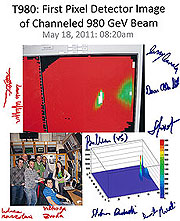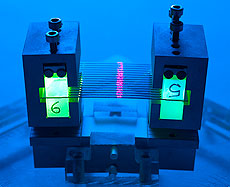Pixel detector to assist beam collimation experiments
 |
Members of the crystal collimation study, a joint program of Fermilab's Accelerator Division, the Accelerator Physics Center, and the LARP program, celebrated their success with the pixel detector at the Tevatron in the Main Control Room on Wednesday, May 18 (lower left). The intensity profile in 2D (top image) and 3D (lower right) acquired by the pixel detector shows that halo particles were channeled away from the main beam with a bent crystal. |
For the first time, on Wednesday, May 18, physicists operated a tiny detector in the Tevatron that will help develop a technology to improve the quality of collision data.
The pixel detector, a device similar to a cell phone camera chip, could help improve beam collimation technology- technology that can remove unwanted particles from around the periphery, or halo, of the beam before they wreak havoc on equipment and data.
The achievement comes after several hurdles in the past year.
The detector was initially built by engineers in Fermilab's Particle Physics Division for the CMS Forward Pixel Detector. In 2010, an engineering team from the Electronic System Engineering Department of the Computing Division took on the task of providing a readout system and software suite specifically for this experiment to allow operation inside the Tevatron vacuum and close to the beam.
Now, a team of physicists from the T-980 crystal collimator project is using the detector to perform beam collimation experiments.
Difficulties with installing the pixel detector in the beam arose when moisture trapped in the electronics prevented vacuum from being achieved in the beamline, said Gerry Annala from Fermilab's Accelerator Division.
Once conditions were optimized to remove the water, the collaboration successfully installed the detector. They are now investigating the ability of devices made of bent crystals to remove halo particles and produce a tight, narrow beam suitable for clean particle collision experiments.
The halo around a beam results from particle diffusion away from the high-intensity center. If not efficiently removed, the halo can damage the superconducting magnets and cause high backgrounds in collision data that make data interpretation more challenging, said Todd Johnson from Fermilab's Accelerator Division.
For as long as particle accelerators have been around, scientists have investigated different technologies to remove the halo. Current technologies employ materials, made of tungsten or carbon, which scatter the particles in all directions. More recently, scientists have explored bent crystals for their ability to efficiently direct, or channel, undesired particles away from the main beam.
"There are very high electric fields between atomic planes in a crystal," said Nikolai Mokhov, Fermilab scientist and spokesperson for the crystal collimation study. "Particles get trapped and travel between the planes following the field."
"You can do many interesting things with a bent crystal," Mokhov added, explaining that you can channel unwanted particles away from the beam where a collimator can catch them downstream. "It's an amazing thing that a 3 millimeter crystal can do the work of a 20-Tesla dipole magnet."
Bent crystals have potential applications at the LHC, which will eventually require more efficient collimation than what the current technology allows.
 |
One of the bent crystal devices currently being tested in the Tevatron Experiment T-980 is shown above. The device is composed of 16 separate crystals and was designed by INFN. Credit: Reidar Hahn. |
"A new era of collimation is needed because as you go to higher intensities, beam instability becomes more of an issue," said Dean Still from Fermilab's Accelerator Division and co-leader with Mokhov for the crystal collimation study.
Given the sensitive nature of the crystals, which require extremely precise positioning next to the beam in order to efficiently channel the halo particles away, it will take time and hard work to determine their full potential.
"The crystals are very delicate and the components are tiny, so it's very difficult to get it to work," Mokhov said.
The collaboration hopes to make significant strides over the next week using the pixel detector in the Tevatron.
"If all goes well, we will be able to provide machines like the LHC with more data and more information to determine whether this is a viable solution for part of their collimation system in the future," Still said.
— Christine Herman
|